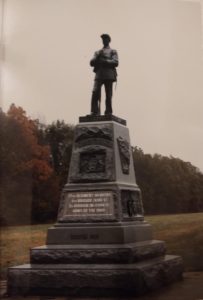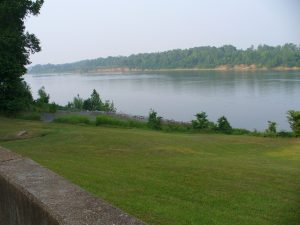From Pittsburgh to Pittsburg Landing: Pennsylvanians at Shiloh
Drive by the monuments on the park tour road at Shiloh or glance through the Union Order of Battle and it stands out: among the dozens of units from Iowa, Michigan, Indiana, Ohio, and Illinois, is a lone Pennsylvania Regiment. The 77th was the only eastern unit on the field at Shiloh (there were other Pennsylvanians here, men from Cambria County in the 19th U.S. Infantry). I was curious about their story, and how they ended up here.
Few eastern units served with the western Union armies in places like Georgia, Tennessee, and Mississippi. The 77th Pennsylvania was one of the first eastern unit to arrive and serve in the west. Its men came from the counties of Allegheny (including the city of Pittsburgh), Huntingdon, Mercer, Fulton, Blair, Luzerne, Franklin, Beaver, Dauphin, and Lancaster. They were mostly from the central and western parts of the state.

The regiment was organized at Pittsburgh on October 15, 1861 and left for Louisville, KY three days later. They were attached to Negley’s 4th Brigade, McCook’s Command, in General Don C. Buell’s Army of the Ohio. In December, 1861 they transferred to the 5th Brigade, led by Colonel Edward Kirk.
The unit marched to Bowling Green, KY, then onto Nashville, TN by February, 1862. Through March and April they moved to rendezvous with General U.S. Grant’s Army of the Tennessee, camped at Pittsburg Landing. In the meantime the Confederates struck Grant’s camp on April 6, opening the battle of Shiloh. Pushed back and suffering heavy casualties, Grant was desperate for Buell’s army to arrive and help.
The advance divisions of Buell’s force reached Savannah, eight miles from the battlefield, on the evening of the 5th. The next morning the troops heard the sound of battle in the distance. Buell’s troops marched down to a point across the river from Pittsburg Landing by evening, ready to be ferried across.
The 77th arrived about midnight, far in the back of the column. Standing in the rain that night, they awaited their turn to cross the river, doing so around four in the morning of the 7th. The men made their way through the crowd of wounded and stragglers, up the muddy hill, to join the fray. Perhaps they reflected on the irony of having come hundreds of miles from Pittsburgh, PA to this remote Pittsburg Landing. They might have also wondered, if they ever saw it spelled, why it was missing the “h.” (There was little uniformity in how the Pennsylvania city was spelled: sometimes Pittsburg, sometimes Pittsburgh. The city government always used an “h” and in a 1911 meeting, the chamber of commerce and various corporations agreed that it should have an “h” and from then on this became the accepted practice.)

Colonel Frederick Stumbaugh led the 77th forward, over ground that saw hard fighting he day before, passing through abandoned camps, hundreds of dead and wounded, and the debris of battle. By mid-morning they were on the front lines with the rest of Kirk’s brigade, engaged with the Confederates, who had largely lost their momentum and were on the defensive. Kirk’s troops entered Review Field, on the right of the Union line, with the 77th on the brigade’s left.
Here they endured their first battlefield casualties as they came under artillery fire. For the next few hours they exchanged fire with the Confederates, until shifted to assist the brigade on their left. Here, around 2 p.m., they charged across the field, over the Purdy Hamburg Road, captured two guns, and the colonel of the 20th Tennessee.
They then repelled two cavalry charges made by Morgan’s Kentucky cavalry. The weight of fresh Union reinforcements tipped the balance and soon after 3 p.m. the Confederates began to disengage and pull back, abandoning the field. The eastern rookies had fought well, and their losses were light: 3 killed, 7 wounded.
The 77th served the rest of the war in Western Theater, fighting at Stones River, Chickamauga, Chattanooga, the Atlanta Campaign, the Nashville Campaign, and ending the war at Victoria, Texas, even further from home.
Nice job, Bert!
Bert, Thanks for mentioning the “H” in the name of the city. Also enjoyed your writing style!
thanks Bert … great story about the 77th … who knew there were Pittsburg(h)ers at Shiloh!
Great summary. The 77th Pennsylvania fought right beside one of my ancestral units, the 30th Indiana. The 30th’s colonel, Sion Bass, was mortally wounded in the action you mention.
I have the 77th’s regimental history, which is quite good. There is a vivid description of the regiment’s experience crossing the river, but no remark on the name “Pittsburg Landing.” Had there been more Allegheny County men in the unit, it might have generated a stronger reaction.
Western Pennsylvania was well represented in the Western Theater of the war.
The 77th and 78th were organized in Pittsburgh on 15 October 1861 and 12 October 1861, respectively. The 79th Pennsylvania Infantry was comprised of companies from Lancaster and Washington(in western PA) counties. The three regiments were in Negley‘s 4th Brigade, McCook’s Command, at Nolin, Army of the Ohio, until November 1861. Although they would never serve together in the same brigade or division, they did fight many of the same battles later in the war.
Mark, if you’re ever in the Burgh, I encourage you to take the time to visit the Soldiers and Sailors Memorial Hall. It proves Pittsburgh has more than just Super Bowls and Stanley Cups to be proud of!
Chris, I also have Pennsylvania at Shiloh and recently acquired Pennsylvania at Chattanooga Chickamauga. I hope it’s as good as the first.
thanks Dean … it’s on my list to visit.
Good to see another Shiloh article on here. Would like to comment on this “They then repelled two cavalry charges made by Morgan’s Kentucky cavalry.” Can you tell me where you got this information? I know they faced cavalry as they charged in the wake of Grant’s attack at Review Field, but my evidence has Morgan’s men not engaged on April 7. The more likely canidate was one of the cavalry regiments protecting Hardee as he withdrew west from Sarah Bell Field to Rea Field.
Hi Sean,
I used Larry Daniel’s and Wiley Sword’s books, as well as reports in the OR. I believe my source on this topic is from Sword.